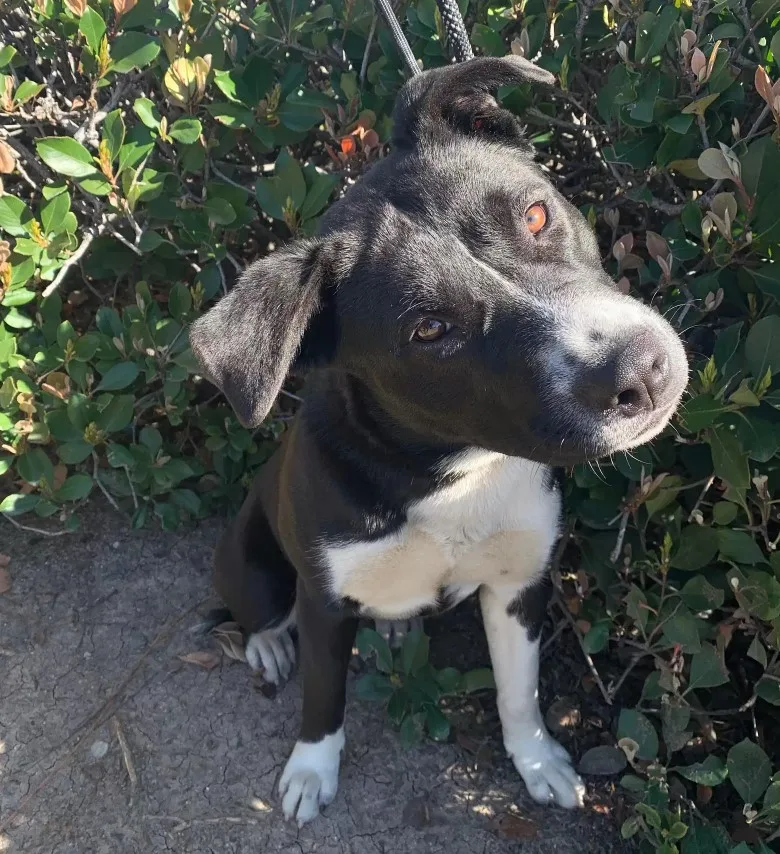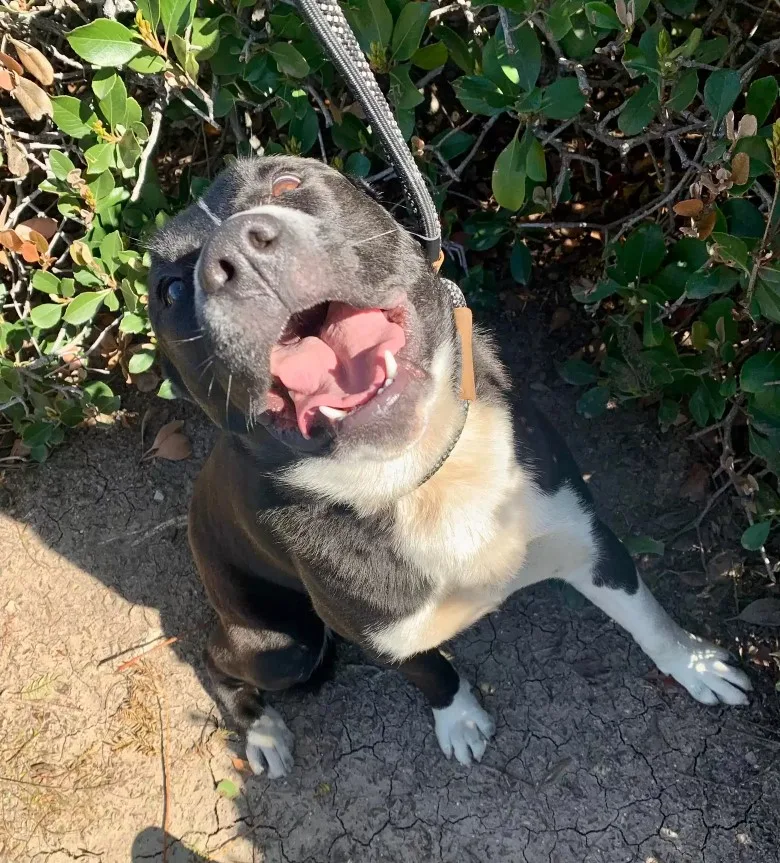Dogs are known for their unwavering loyalty, their steadfast devotion to their human companions, often surpassing all expectations.
Yet, there are rare instances when a dog’s loyalty transcends the boundaries of our imagination, leaving us in awe of their indomitable spirit.
Such is the extraordinary tale of Nirvana, a canine whose extreme loyalty captivated the hearts of all who crossed her path.
A Loyal Dog’s Heartbreaking Ordeal

Nirvana, an unsuspecting Pittie, found herself abandoned in an empty lot next to a car wash when her family left her behind with only a blanket and some food.
Unbeknownst to them, Nirvana’s loyalty would lead her to patiently wait for their return, curled up on the curb with her belongings.
But, her family never returned.
A Caring Community

Moved by her unfortunate situation, they set out a fresh bag of food in hopes the dog would eat.
A Gentle Rescue

After two days of waiting, Hall arrived to rescue the weary dog. Despite her fatigue, Nirvana mustered the energy to greet her rescuer, showing a flicker of hope and recognition.
The wag of her tail and the gleam in her eyes spoke volumes about the enduring bond between humans and their loyal canine companions.
This moment of connection with Hall shows how much trust and love dogs place in their human counterparts, even in the face of abandonment and heartache.
Nirvana’s Healing Journey Begins

With gentle gestures and a soothing tone, she assured Nirvana that she was there to help, to provide the care and compassion that had been denied to her by her former family.
The pup was so sleepy that she barely even reacted to Suzette! Her exhausted state was evident, but she knew she was finally being saved.
Hall promptly took her to the vet, where Nirvana received a much-needed bath that seemed to wash away the sadness that clung to her!
From Heartbreak To Happiness

Recognizing her sweet nature and unbreakable spirit, they provided her with her own kennel and began the healing process.
In a matter of days, Nirvana found herself in a loving foster home, where she could leave her sad past behind.
Embraced by her foster mom’s affection and enjoying outdoor adventures, the loving Pittie discovered a new lease on life – a life full of joy and tail wags!
Her playful and grateful nature serves as a reminder of the remarkable capacity of dogs to bounce back from abandonment and shower unconditional love on those who care for them!
Together, let us create a world where no dog waits alone on a curb, but instead finds peace, love, and a forever family to call their own!
If you’ve ever been curious about expanding your furry friend’s vocabulary or simply want to impress your Spanish-speaking pals, learning how to say “dog” in Spanish is a fun and useful place to start. As a seasoned dog enthusiast, you know that communication with your canine companion goes beyond just barks and tail wags. Adding a new command in another language can not only be exciting for you but can also stimulate your dog’s cognitive abilities.
Imagine the look of surprise on your pup’s face when you introduce them with a new word in Spanish. It’s a small yet impactful way to strengthen the bond between you and your four-legged buddy. So, whether you’re aiming to enhance your language skills or just want to see your dog’s tail wag a little faster, mastering how to say “dog” in Spanish is a delightful endeavor worth pursuing.
Exploring Ways to Say “Dog” in Spanish
Basic Terms:
Learning how to say “dog” in Spanish is a simple yet enriching experience. The word “perro” is commonly used in Spanish-speaking countries to refer to man’s best friend.
Different Dialects:
In Latin America, you might come across the term “perrito” as a more affectionate way of calling a dog. Similarly, in Spain, “can” or “chuchito” are also used to express endearment towards dogs.
Informal Expressions:
Some informal expressions for a dog include “chucho” or “touto,” depending on the region. These terms are more casual and can vary in different Spanish-speaking countries.
Playful Nicknames:
Beyond the formal terms, dog owners often use playful nicknames for their furry companions. In Spanish, terms like “peludo” (hairy one), “patas” (paws), or “fiel amigo” (loyal friend) are commonly heard.
Cultural Significance:
Understanding the various ways to say “dog” in Spanish not only enhances communication but also allows you to appreciate the cultural nuances of different Spanish-speaking regions.
Enhancing Bond:
Using these terms with your Spanish-speaking friends or when communicating with your pet in Spanish can strengthen the bond between you and your furry companion.
Wrap-Up:
Mastering the Spanish word for “dog” opens up a world of linguistic and cultural enrichment, making your interactions with your pet and Spanish-speaking friends even more enjoyable.
The Literal Translation of “Dog” in Spanish
So, how do you say “dog” in Spanish? The word you’re looking for is “perro.” It’s the most common and straightforward term used to refer to our faithful canine companions in the Spanish language. When you’re with your Spanish-speaking friends or trying to communicate with locals, calling a dog a “perro” will make sure you’re understood clearly and effectively.
In Latin America, an endearing way to refer to a dog is by using the term “perrito.” This term adds a touch of affection and warmth, making it perfect for showing your love for these furry friends. It’s a sweet and caring way to address your beloved pet and may even bring a smile to those around you when they hear you use it.
For those playful moments or when you want to add a bit of charm to your interaction, you can use fun nicknames like “peludo” (hairy) or “fiel amigo” (faithful friend) to refer to your dog. These terms convey a sense of playfulness and endearment, perfect for light-hearted conversations or when describing your furry companion’s traits in a more colorful way.
Learning these different ways to say “dog” in Spanish not only broadens your vocabulary but also deepens your understanding of the cultural nuances within the language. It helps strengthen your bond with your pet and enriches your interactions with Spanish speakers, creating memorable moments for you and your furry friend.
Common Alternatives for “Dog” in Spanish
When it comes to addressing our furry friends, there are various ways to say “dog” in Spanish. Here are some common alternatives you can use to refer to your canine companions:
- “Perrito”:
In Latin America, “perrito” is often used to show endearment towards smaller dogs. It adds a touch of affection to your pet’s name. - “Can”:
“Can” is another word for dog in Spanish, used in various Spanish-speaking countries as a simple yet effective way to refer to man’s best friend. - “Tuto”:
In some regions, “tuto” is a playful and affectionate term for a dog that can bring a smile to your face while addressing your four-legged pal. - “Chucho”:
This term is commonly used in Spain to refer to a mutt or a mixed-breed dog, showcasing the diversity and uniqueness of our canine companions. - “Perrete”:
“Perrete” is a diminutive form of “perro” and is often used to convey a sense of closeness and familiarity with your pet.
By incorporating these alternative terms into your conversations about dogs in Spanish, you can enrich your pet’s experience and strengthen the bond between you and your loyal companion. These terms not only add variety but also showcase the linguistic diversity and cultural richness associated with our beloved furry friends.
Cultural Perception of Dogs in Spanish-Speaking Societies
In Spanish-speaking societies, dogs hold significant cultural importance and occupy various roles. Understanding the cultural perception of dogs in these societies can provide insights into the unique relationship between humans and dogs.
1. Role as Companions:
Dogs are often seen as loyal companions in Spanish-speaking societies. They are valued not just as pets but as members of the family, providing companionship and emotional support to their owners.
2. Symbolism in Literature and Art:
Dogs have been featured prominently in Spanish literature and art, symbolizing loyalty, protection, and companionship. Their presence in various artistic expressions reflects the deep admiration and significance attached to them.
3. Traditional Beliefs and Superstitions:
In some Spanish-speaking cultures, dogs are believed to possess protective qualities and are associated with good luck or warding off evil spirits. Such traditional beliefs highlight the positive perception of dogs in these societies.
4. Working Roles:
Beyond companionship, dogs in Spanish-speaking societies often fulfill working roles, such as herding, guarding, or assisting in various tasks. These roles showcase the versatility and utility of dogs within different cultural contexts.
5. Influence on Festivities and Celebrations:
Dogs also play a role in local festivities and cultural events in Spanish-speaking societies. They might participate in parades, wear special outfits, or be part of ceremonies, emphasizing their integration into community celebrations.
Understanding the cultural perception of dogs in Spanish-speaking societies offers a glimpse into the deep-rooted connection between humans and these beloved animals, illustrating the multifaceted roles and significance they hold within diverse cultural contexts.
Conclusion
That’s all about how you say “dog” in Spanish! Learning these terms not only enhances your communication skills but also deepens your understanding of the cultural significance of dogs in Spanish-speaking societies. From “perro” to “fiel amigo,” each word carries a unique essence that reflects the special bond between humans and their furry companions. By immersing yourself in these linguistic nuances, you gain a richer perspective on the roles that dogs play in different aspects of life, from literature to festivities. So, next time you interact with a Spanish speaker or your furry friend, remember these words and appreciate the diverse ways in which dogs are cherished and celebrated across cultures.
Frequently Asked Questions
What are the benefits of learning different ways to say “dog” in Spanish?
Learning various ways to say “dog” in Spanish can improve communication with Spanish-speaking friends and strengthen the bond with your pet. It can also provide cognitive benefits for dogs, helping them associate commands with actions better.
What are some terms used to refer to dogs in Spanish?
Some terms used to refer to dogs in Spanish are “perro” (dog), “perrito” (puppy), “peludo” (furry one), and “fiel amigo” (loyal friend).
How are dogs perceived in Spanish-speaking societies?
Dogs in Spanish-speaking societies are perceived as cherished companions, with significant symbolism in literature and art. They also hold traditional beliefs, serve in various working roles, and influence festivities, showcasing their deep cultural connection with humans.
[no_toc]

Hey there, I’m Janet Brooks, a dog-loving student from California. I’m all about helping pups in need, especially those without homes. Me and my awesome friends work together to give shelter and love to stray dogs. Oh, and I also write blogs about dogs to share helpful info.